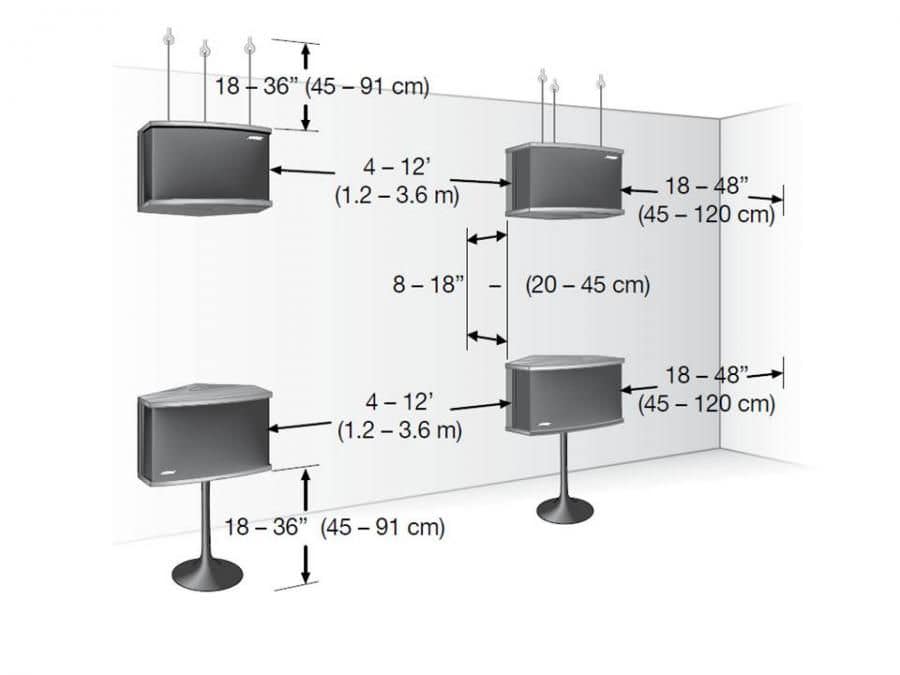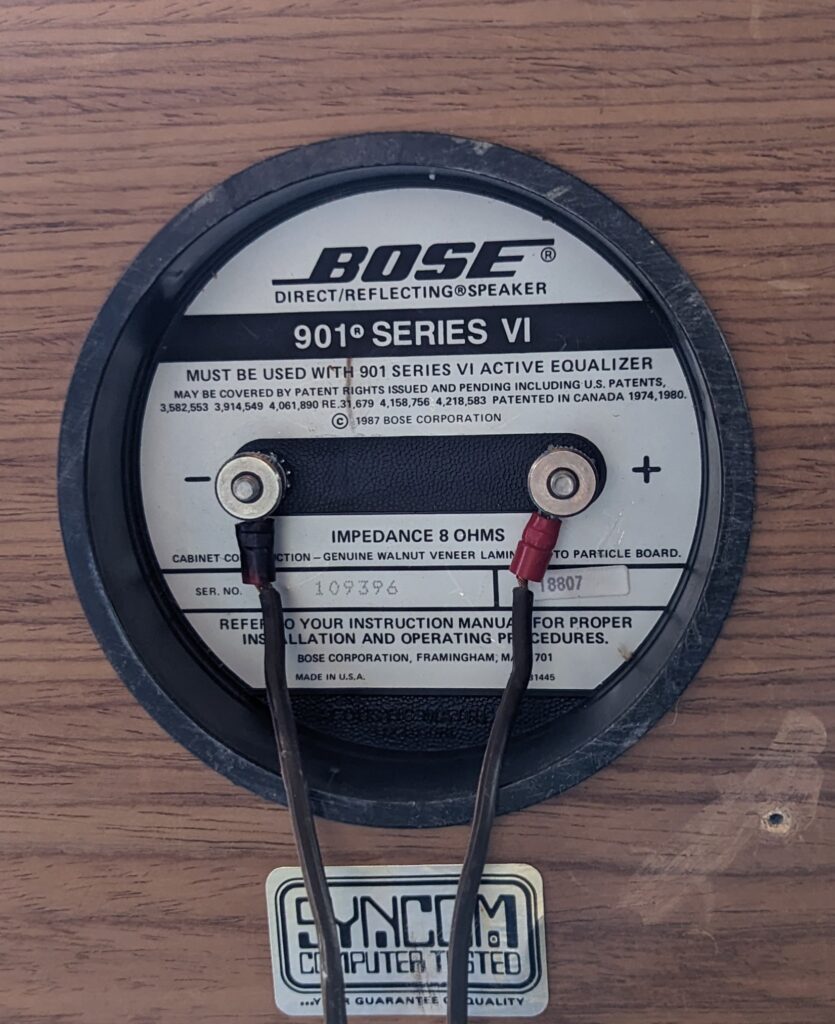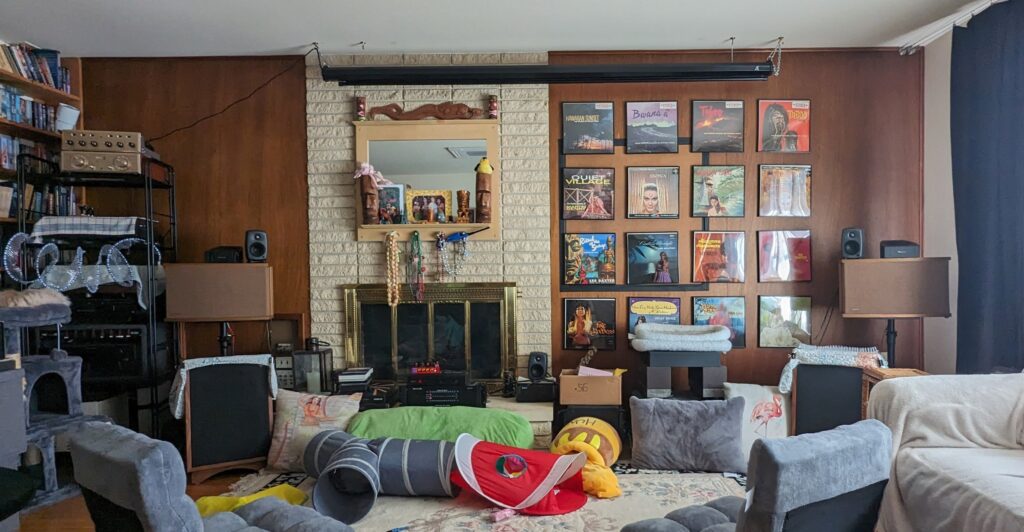Note: 2023.12.06: I have refactored the original Bose page into multiple pages, as it was getting extremely large and hard to navigate. The current pages are:
- A page about the various incarnations of the 901 speaker system: Bose 901 Series – Generational History – this page
- A page with collected company history and anecdotes is here: Bose Company Memories
- A page about the Syncom speaker grading system used is here: Bose Syncom system info
- My lab notebook page on tests and modifications on my personal pair of Version 6 901’s is here: Daev’s Lab Notebook: a 901 Series VI journey (this page)
My Bose 901’s
I inherited my Dad’s beloved speakers, a pair of Bose 901 series VI, along with the correct series VI “Active Equalizer” box. These are very polarizing speakers in the hi-fi world, so I’m curious to see what I think. I’ll restore as needed back to factory spec, and then evaluate the sound for my self.
The previous 901 Series VI version 2 was officially the last version, although one could reasonably argue the Series VI, Version 2 should have really have been called the Series VII, based on the driver and eq changes.)

A typical Series VI pair
IIRC, when set up properly these were great sounding for symphonic and big band, not so good for chamber, jazz, or hard rock… and terrific as low to medium volume “background party music” speakers. Measurements and listening will tell the tale…

Proper setups, according to the Bose 901 owners manual.
The “active eq” processor box
As an old techie, the first thing I looked at is the “Active Equalizer” or processor to see if I need to fix or rebuild anything. It actually appears to be in decent shape, despite it’s years. THD and noise is right where a reviewer and the service manual said it should be, with no visible signs of bad caps. The EQ curve seems about right as well.
Here’s a graph of the series 6 processor box’s EQ curve with controls set to the detent.

Measured with 500 mV input. The frequency reference point is 3200 Hz, which corresponds to a unity gain point through the EQ signal path.(This is the second version of this chart, a prior one with a 1 kHz reference had a weird scale that was awkward to analyze.)
– THD is good in the normal audio range, below 0.05%.
– But check out those huge eq boosts and cuts! That weird wrinkle in the 1.5 to 3k range is odd, as is the one at about 350 Hz. This complex EQ curve can’t be fully emulated with out a parametric EQ, a simple graphic EQ isn’t agile enough.
– Lastly, the abrupt falloff at 35 Hz suggests crossing over to a subwoofer in the range of 50 to 80 Hz would be a good idea.
Note: The pro PA version of this unit, the 802, actually has some published specs. A couple of interesting ones are:
-Recommends a high pass filter at 55Hz (12dB/octave).
-Bandwidth is rated from 52Hz to 15kHz
The Speakers
The low speaker sensitivity (appx 81 dB sensitivity – 2.83V @ 1 meter, disputed as also 89) along with the later generation ported design suggests a high power amp with a high damping factor for these speakers will yield the best results.
I have several amp candidates
– A QSC PLX 1602 – 300W into 8 ohms (20 Hz-20 kHz 0.03% THD). Also into 2 ohms appx 800W, relevant if I do a bit of rewiring on the speakers.
– I also have a QSC PLX 3102 rated at 600 watts/chn, and an astonishing 1500 watts/chn into 2 ohms. (!)
– A SAE 2200, appx 100 watts/chn
– A Hafler Pro 500, appx 250 watts/chn
2023.11.02 – Speakers arrived at my house. Excited unpacking noises ensue.

One speaker’s serial number…
So not a fan of the whacky terminals, but at least they’re recessed. But why isn’t the cup centered in the cabinet? My guess is it’s the center of gravity point.

…and the other one. Interestingly, they’re not sequential serial numbers. But close.
Color variation is just lighting, the cabinets do in fact match.
You can also see the surprisingly awkward way the stands are secured with wood screws into the cabinet, a failure prone attachment method that messes up the finish too. Not a fan.
The date on the speaker cup label is 1987.

Looks like I lucked out, no signs of surround rot. Current lore (as of 2023/10) believes the rot issue was resolved towards the end of the series V run, and the entire Series VI series 1 and 2 never had the problem. Yay me.
A quick buzz and rattle frequency sweep didn’t turn up any issues either, so I’ll do a little cabinet cleanup and then off for quick listen.
The M.C.M. tulips look retro/cool, but they have… issues.
- They ring like crazy when tapped. That can’t be good.
- They are way too short for my ear level.
- They are rather unstable on carpet, especially around my large and enthusiastic cats.
- They attach to the cabinet bottom with annoying wood screws, which make the cabinet wood crumble and is, frankly, a horrid way to treat speakers. And this weird mounting schema also gets in the way of the speaker connections on the speakers bottom side. It’s just too cheap for these nice speakers.
So: - I’ve ordered some better speaker stands. The stands are adjustable vertically, they have a much wider tripod stance. I’ll modify the stands by punching a hole for the speaker wiring, and drill a couple of extra holes to mount the plate to the 901 speaker securely. To do so, I filled the MCM stand mounting holes on the cabinet bottom and then installed 4 threaded threaded inserts to attach to the stands: “E-Z Lok Threaded Insert, Hex-Flush, #10-24″ using 1/2” #10-24 hex head screws.
- Since I’ll likely forget to be careful next time I separate the speaker and stand, I’ll rig up a safety disconnect with banana jacks for the speaker wiring .
- Lastly, I’ll put some solid rubber feet on the cabinet bottom to avoid scuffing it further, to handle shelf/stage placement situations, and to avoid squashing the wiring when used without the stands.
- After putting all this together the speakers were too wobbly and made a creaking noise. (ugh) Large steel and rubber washers alleviated this.
It’s 2024, February: I finally had the time to rearrange my living room to accommodate the 901’s.

First placement, appx 8″ from back wall.
When you live in a small shared space place, compromises must be made. And negotiated. ![]() In this case, the 901’s must clear the tops of the floor speakers and be cat safe. The speakers are about 9″ off the back wall, in line with the official placement recommendations.
In this case, the 901’s must clear the tops of the floor speakers and be cat safe. The speakers are about 9″ off the back wall, in line with the official placement recommendations.
(Please excuse the move-in mess, I needed to do a quick listen to see if this was even gonna work, sound-wise. After a quick 30 minutes listening session, I deem it acceptable.
Initial impressions:
+ The broad sound field works nicely for larger recorded spaces, and can really open up older congested recordings (like the remastered Glenn Miller stuff). Arena rock was fun
+ Club and trance had good punch and energy.
+ Mickey Hart’s “Drum Planet” is a standout!
– Chamber music was interesting, but I felt the instrumental presentations were too wide. – Likewise, vocal forward rock had a lack of placement precision and focus. Linda Ronstadt’s voice was about 4 feet wide.
Dark Side of the Moon, Brothers in Arms and Aja up next.
The temporary electronics test setup is sitting on the fireplace hearth. Turns out the SAE 2200 is pretty good match, I’ll keep it a while.
The mini monitors on the 901’s and room center are Genelec 8010A’s mini monitors, used for the home theater. The floor speakers are Klipsch Heresey 3’s driven from a tube amp or a Hafler SE-120 (a SS MOSFET) amp.
Things to try
- See how well a dbx drive rack PA2 can be used to effectively replace the Bose processor box. The extra headroom of the pro level +4 dbV signal path will be helpful here, especially when fed to the “pro” QSC amp. I plan to use the output PEQ (+/- 20dB parametric) to first cut/flatten that large midrange hump, then use the Auto PEQ to trim up the overall in room frequency response. That leaves the GEQ (+/- 12dB GEQ for touchups and house curves.
UPDATE: This actually works rather well! I did a basic flatten of the 901’s using the post crossover PEQ, and then let the room correction pass handle the fine tuning. Here’s the initial settings:
Band 1: Cut 8.0 dB @ 600 Hz, Q2 – Flattens out much of the midrange hump.
Band 2: Boost 8.0 dB @ 9.01 kHz, Q1 – Extends high end.
Band 3: (If using a sub, not needed.) If no sub, band 3 is boost 8dB @55Hz, Q 3.44.
– The dbx built in RTA is quite useful, as is the complete control from a PC or iPad via the usual app. The output PEQ does the bulk of the heavy lifting to emulate the basic 901 eq curve, the crossover handles those chores with aplomb, the room correction is fast and easy to use, and the front end graphic EQ can easily tweak for source or personal taste without disturbing the calibrated speaker EQ’s. Win. - I’ll bet these speakers will be much happier with a subwoofer, based on that huge bass boost in the processor and the amount of port chuffing I hear below 50 Hz. This is also trivial to do with a dbx drive rack PA2, yay.
- A more radical idea: Since a 4″ driver isn’t the best for high frequencies due to beaming, try adding a Linaeum super tweeter on top (from Optimus LX-5s) with the dbx active crossover at 8 kHz. May have to acoustically pad down the rear reflections to blend with the 89/11 ratio, and/or sound treat the top of the 901 for reflections. The LX-5 Linaeum was crossed over at about 5K with a simple 6dB bass blocker series cap of 6.2 uF, and I’ll keep that value as a tweeter protection device. UPDATE: The Linaeum tweets indeed add significant sparkle and better dispersion on the high end, and I’ll bet the imaging improves without destroying the lush enveloping sound. My instruments say the high end is smoother and has better extension. My ears say transient response of triangles is better and there’s more “air”.
- Take some in-room and outdoor measurements! Characterize the speaker w/o the “Active Equalizer” as well as with.
- Investigate flipping them around and using as a small venue “802 type” PA speaker, only with a built in stage monitor. 🙂 Apparently, this was what the first tests of the 802 concept was done with.
- Investigate rewiring the 901’s to be a 2 ohm load, the extra 4 dBW of amp headroom is probably worth it. The idea is rewire the series string into a 5/4 series parallel string, using a switch or a jumper so it’s easily changeable.
- A more radical idea: Since a 4″ driver isn’t the best for high frequencies due to beaming, try adding a Linaeum super tweeter on top (from Optimus LX-5s) with the dbx active crossover at 8 kHz. May have to acoustically pad down the rear reflections to blend with the 89/11 ratio, and/or sound treat the top of the 901 for reflections. The LX-5 Linaeum was crossed over at about 5K with a simple 6dB bass blocker series cap of 6.2 uF, and I’ll keep that value as a tweeter protection device. UPDATE: The Linaeum tweets indeed add significant sparkle and better dispersion on the high end, and I’ll bet the imaging improves without destroying the lush enveloping sound. My instruments say the high end is smoother and has better extension. My ears say transient response of triangles is better and there’s more “air”.
Last Updated on 2024-03-25 by Daev Roehr
